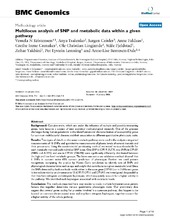| dc.description.abstract | Background: Complex traits, which are under the influence of multiple and possibly interacting genes, have become a subject of new statistical methodological research. One of the greatest challenges facing human geneticists is the identification and characterization of susceptibility genes for common multifactorial diseases and their association to different quantitative phenotypic traits. Results: Two types of data from the same metabolic pathway were used in the analysis: categorical measurements of 18 SNPs; and quantitative measurements of plasma levels of several steroids and their precursors. Using the combinatorial partitioning method we tested various thresholds for each metabolic trait and each individual SNP locus. One SNP in CYP19, 3UTR, two SNPs in CYP1B1 (R48G and A119S) and one in CYP1A1 (T461N) were significantly differently distributed between the high and low level metabolic groups. The leave one out cross validation method showed that 6 SNPs in concert make 65% correct prediction of phenotype. Further we used pattern recognition, computing the p-value by Monte Carlo simulation to identify sets of SNPs and physiological characteristics such as age and weight that contribute to a given metabolic level. Since the SNPs detected by both methods reside either in the same gene (CYP1B1) or in 3 different genes in immediate vicinity on chromosome 15 (CYP19, CYP11 and CYP1A1) we investigated the possibility that they form intragenic and intergenic haplotypes, which may jointly account for a higher activity in the pathway. We identified such haplotypes associated with metabolic levels. Conclusion: The methods reported here may enable to study multiple low-penetrance genetic factors that together determine various quantitative phenotypic traits. Our preliminary data suggest that several genes coding for proteins involved in a common pathway, that happen to be located on common chromosomal areas and may form intragenic haplotypes, together account for a higher activity of the whole pathway. | en_US |
